 |
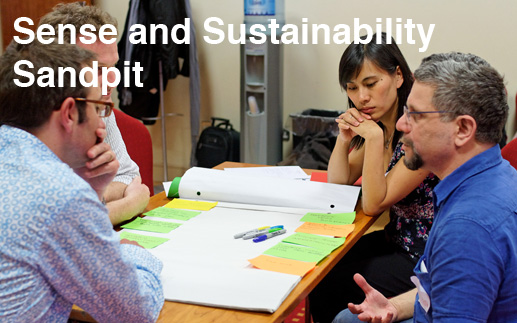
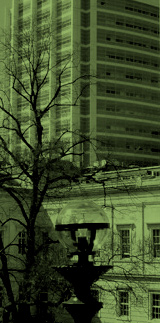
Participants
Gallery
to be continued
Sense and Sustainability:
Networked Sensors for the Urban Environment
The 20th and 21st of May 2010 saw a group of UCL academics meeting in Greenwich to identify ways in which networked sensor technology could be used to address urban sustainability problems.
The two-day sandpit resulted in four research groups obtaining funding to begin investigating novels ways of using technology to address urban sustainability challenges.
.png)
The four funded research programmes were:
- What's my energy footprint?
- Presence Monitoring
- Energy Monitoring
- Location Monitoring
- Wireless Devices
- Spatio-temporal description of air quality with mobile and static arrays of MOS sensors
- Wireless Sensor Networks for Energy Efficiency in Historic Properties
- Energy Efficiency for the Computer Cloud
This project will investigate the ways in which energy use can be inferred by tracking individuals and using multiple data sources to monitor their energy usage as they change location and activity.
The approach is highly reliant on sensors and methods for data fusion. Monitoring energy usage will rely on:
To deliver this detailed, individual energy profile, the team will engage with stakeholders and develop a mobile app that will monitor an individual's movements and activities.
This project aims to study how MOS sensors can be used to improve street pollution modelling and aid emergency response.
One of the key challenges is improving the MOS sensors selectivity towards analytes (the particles and gases under investigation). The project will also look at ways to reduce the size and weight of the sensor package, whilst maximising portability and lifetime?
This project asks can we improve the energy usage of heritage buildings by better understanding how people behave in them?
The conditions required for conservation are not always in line with the conditions required for visitor comfort. The aim of the work is to identify the most important factors affecting the energy efficiency of heritage buildings, and how the conservation needs can be met in the most energy efficient way.
The team plan to investigate the potential for combining smart energy meters and wireless sensor networks that monitor temperature, relative humidity and movement sensors.
This project aims to develop and test algorithms that would allow companies to leverage cloud computing, and the upcoming smart grid for energy, to reduce energy consumption for computing. Cloud computing lets companies move processing to servers in different locations, as well as choosing to delay less urgent jobs. This flexibility allows companies to take advantage of the differences in electricity costs in different locations and at different times.
Potentially the results of this work would allow computer processing to be efficiently spread across the "cloud", with the potential benefits of reducing energy usage and extending the life of data centres. The team also raised the potential of factoring in the heating effect of data centres, introducing the idea that we one day we may see combined heating and processing centres.
The groups are currently working on their research projects, so please check back to find out more about how the research projects are progressing.
Keep reading to find out more about the sandpit.
Behind the scenes at the sandpit
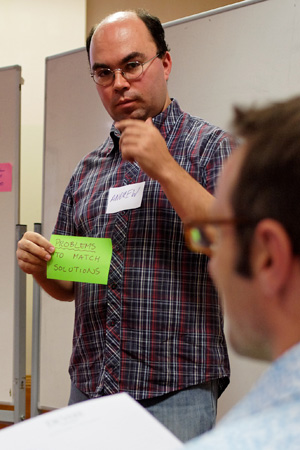
The Sense and Sustainability sandpit drew together a group of academics from across UCL, the only requirements were an interest in sensor technology or sustainability challenges, or both, and a willingness to work across disciplines with other UCL researchers.
Participants came from across UCL:
- Centre for Sustainable Heritage Bartlett School of Graduate Studies
- Chemistry
- Civil, Environmental and Geomatic Engineering
- Computer Science
- Electronic and Electrical Engineering
- Statistical Science
This combination of participants put an impressive amount of specialist knowledge in the same room. The sandpit had experts in sustainability, the urban environment, sensor systems and data handling.
The picture on the right shows Andrew Clark, the BEAMS school research facilitator, during the ideas generation phase of the sandpit. Generating ideas was the starting point of the process, and involved all of the participants discussing sustainability challenges and possible sensor based solutions.
Identifying the sustainability challenges
In the first phase of idea generation the group raised pressing urban sustainability challenges, and also the challenges inherent in using monitoring technologies.
All the challenges were brought together under generally agreed headings, shown in the picture on the left, and listed below.
|
Identifying technologies that could address the challenges
The second phase of idea generation involved discussion of the sensor technologies, or possible advances in sensor technology, that could be used to address sustainability challenges.
As with the exercise to identify the sustainability challenges, the discussion of sensor technologies included issues about the nature of the sensor technologies.
Once again the points were brought together under generally agreed heading, shown in the picture on the right, and listed below.
|
The ideas generation exercises were followed up with a short activity designed to re-energise the group. The pictures below show the group after they were asked repeatedly to find ways of changing their appearance, the images have been kept small to preserve the dignity of all those involved.

Matching solutions to challenges
Combining the challenges and potential solutions into a matrix was the next stage in the sandpit. The matrix allowed all participants to indicate their interest in the combinations.
The image on the left shows Sarah Bell, the Principal Investigator for Bridging the Gaps at UCL, and the matrix, after all the participants had voted on the combinations that most interested them.
The most popular combinations formed the long list for potential research ideas, and provided the basis for teams to start discussing research projects that explored these areas.
The most voted for combinations were:
|
The open space phase of the sandpit allowed participants to move between groups, joining different teams, and contributing ideas.
Over the course of the two-day sandpit research ideas from the long list were developed into workable research proposals.
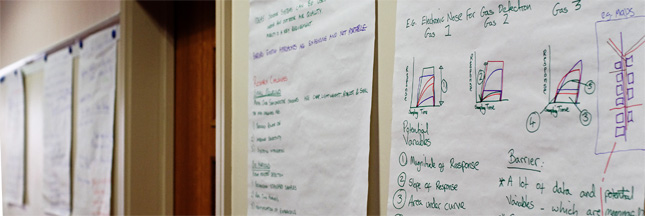
Each team pitched their idea for research, setting out how they would spend different levels of funding. The final funding decision was made by allowing all the participants in the sandpit to vote for their favourite research proposals.
Bridging the gaps held a previous sandpit in 2009 which successfully combined researchers with a knowledge of nanotechnology with researchers who wanted to address urban sustainability challenges.
Disclaimer | Accessibility | Privacy | Advanced Search | Help
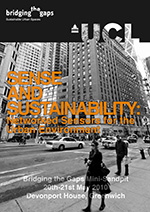
.jpg)
.jpg)
.jpg)
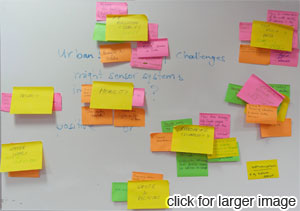
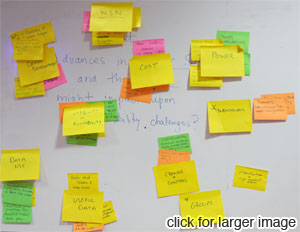
.jpg)